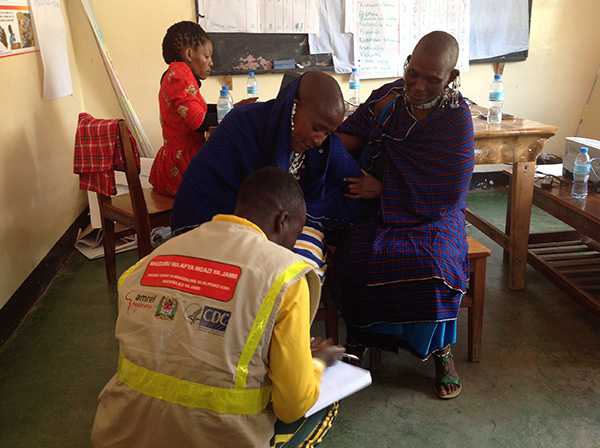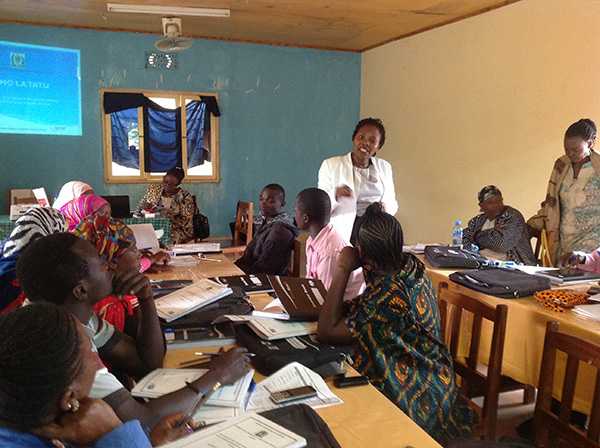Tanzania Surveillance (GHSA) in Action
The Bottom Line
THE CHALLENGE: Tanzania has limited capacity, especially at community level, to detect outbreaks and this weakens its ability to promptly respond and control public health threats or events in a timely fashion.
THE SOLUTION: Amref Health Africa, CDC and Tanzania’s Ministry of Health launched a community-based disease surveillance training for volunteer community health workers and health care workers to investigate and report outbreaks at the community and district level. The ability to quickly identify and control disease outbreaks before they spread to other communities and countries help improve the health security of Tanzanians and other populations around the world.

Role playing how to refer a case to a health facility
Tanzania leverages community structures to improve disease surveillance
Tanzania is filling in the gaps of its health facility-based disease surveillance system to rapidly detect outbreaks by leveraging existing local community structures. Recently, the country successfully piloted an initiative to train community health workers (CHWs) and health care workers (HCWs) in community-based disease surveillance (CBDS) so they can help improve disease detection, prevention, and control at the community level.
CBDS training is funded through the Global Health Security Agenda and implemented by Amref Health Africa in collaboration with CDC Tanzania and the Ministry of Health, Community Development, Gender, Elderly and Children (MOHCDGEC).
A cadre of 500 volunteer CHWs and 114 HCWs from Arusha and Kilimanjaro regions were trained in CBDS in July and August 2016. There are long-term plans to expand the training to other regions in Tanzania.
The training facilitates the early detection of priority diseases by educating the CHWs to send timely and accurate health information about their communities to HCWs at assigned health facilities. Such timely and accurate reporting will improve early warning systems and prevent outbreaks from crossing borders.
Volunteer CHWs are trained on how to engage community members in outbreak investigation, identify diseases using simple standard case definitions, provide referrals, when needed, to nearby clinics or hospitals, and record and report cases to health facilities.
HCWs from local health facilities are also trained to identify diseases using standard case definitions, provide treatment to referred patients, report cases to a district database that feeds into the national Integrated Disease Surveillance and Response system, and report outbreaks and other events of public health importance.

CDC epidemiologist Marcelina Mponela facilitating a training session with CHW in Mwanga District in the Kilimanjaro region
Training in Action
The community is already benefiting from the CBDS training. Just a month after completing the training, a CHW from Arusha region put the training into practice. He reported suspected cases of anthrax in his village to his supervising HCW at a local hospital. Together, they successfully identified, isolated, and sought treatment for four anthrax patients–saving the life of a four-year-old boy and preventing the disease from spreading in the community.
“This project is very important to the Arusha region, especially for the districts with strong cultural practices that impact the health of communities. This will enable data from the community to reach formal health system for health management planning that will help to reduce the rate of outbreaks in the districts,” said Fatuma Msumari, a community based focal person in Arusha region.
Participation of communities in diseases detection and prevention is key to the success of CBDS training. With this in mind, support and buy-in of regional, district, ward, and village leaders, as well as influential religious, health, and tribal figures is sought before communities are trained. As of September 2016, 111 local leaders from five districts in Kilimanjaro and Arusha had been sensitized to support CBDS training in their respective areas.
Amref Health Africa, a CDC partner, plans to train more CHWs and HCWs in the five pilot districts. Meanwhile, the MOHCDGEC has established a one year Community Based Health Program for CHWs. The first cohort will be enrolled into the government system and work closely with the local volunteers in their respective villages.
About This Story
CDC is working with 31 priority countries to develop global health security capabilities, which protect Americans and people around the world from disease threats. This story illustrates Tanzania’s commitment to:
- Real-Time Surveillance: Launching and strengthening global networks of disease-surveillance systems that quickly detect outbreaks and assess risks.
CDC will continue to work with the government of Tanzania and Amref Health Africa to strengthen Tanzania’s disease surveillance systems that detect and respond to public health events. This work ensures that Tanzania and the world community remain safe from disease threats.
- Page last reviewed: December 23, 2016
- Page last updated: December 23, 2016
- Content source:
Global Health
Notice: Linking to a non-federal site does not constitute an endorsement by HHS, CDC or any of its employees of the sponsors or the information and products presented on the site.


 ShareCompartir
ShareCompartir